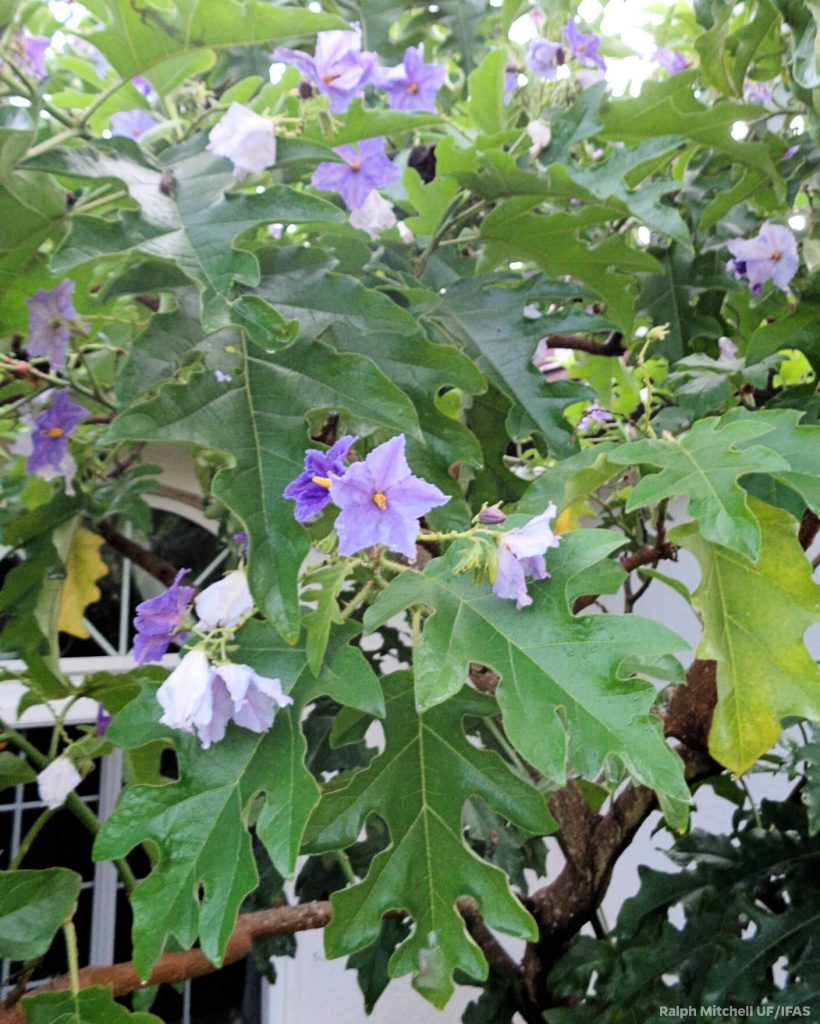
While you might think that the title of this article is the beginning of some children’s story, it is not! The giant potato tree is a real plant up to fifteen to twenty-feet tall with amazing purplish flowers. Although it is related to the potato, it does not produce any, and all plant parts are toxic. As a small, quick-growing tree with large leaves and stunning flowers, the giant potato tree can make a beautiful focal point specimen.
I first saw the giant potato tree on Pine Island and really admired its unique shape and flowers. It was probably twelve feet tall and fairly wide with huge twelve-inch long, oak-like leaves. The undersides of the leaves, stems and branches are armed with sharp thorns, so handle with care! The flowers are color-shifting as they emerge purple, and then fade to lavender and then to white – not unlike Brunfelsia grandiflora – Yesterday, Today, and Tomorrow. All three colors are on the tree at one time providing a multicolor treat for the eyes. Each five-pointed, star-shaped flower has an orange-yellow center accenting the already beautiful bloom. In our area, some flowers are followed by round, golf-ball sized green fruit full of seeds. The giant potato tree can be easily propagated by seed with a great number of seeds germinating – plenty for friends and neighbors! You can also root cuttings. In either case, this tree grows quickly and vigorously, so accommodate it appropriately by steadily repotting until it goes into the landscape.
Pollinators love this Brazilian plant! Carpenter bees and bumble bees are all over the flowers buzzing with delight as they rubble about in search of abundant pollen and nectar.
Again, a reminder that you should consider all parts of this plant toxic as it is in the Nightshade family. Also, don’t forget that the thorns can be a problem. There is a thorn-less cultivar called ‘Thornless’ that is available in the market.
Plant the giant potato tree in full sun in average, well-drained soil. As it is tropical in nature, it can get damaged by frosts, so have suitable frost protection blankets available if necessary. Any damaged leaves and branches tend to grow back in warmer weather without a problem. You can selectively prune it to shape in March each year to keep it in-bounds. Otherwise, the giant potato tree is a vigorous and impressive ornamental plant to include into your landscape. It can be a showstopper, so be prepared for positive comments! For more information on all types of ornamental trees suitable for our area, or to ask a question, please visit https://www.facebook.com/CharlotteMGLifeline/. Ralph E. Mitchell is the Director/Horticulture Agent for the UF/IFAS Charlotte County Extension Service. He can be reached at 941-764-4344 or ralph.mitchell@charlottecountyfl.gov.
Resources:
Arnold, M. A. (2014) Solanum macranthum. https://aggie-horticulture.tamu.edu/syllabi/308/Lists/Fourth%20Edition/Solanummacranthum.pdf
Chin, J.(2010) Solanum macranthum with gorgeous tri-coloured blossoms. John & Jacq’s Garden.
 1
1

Comments are closed.